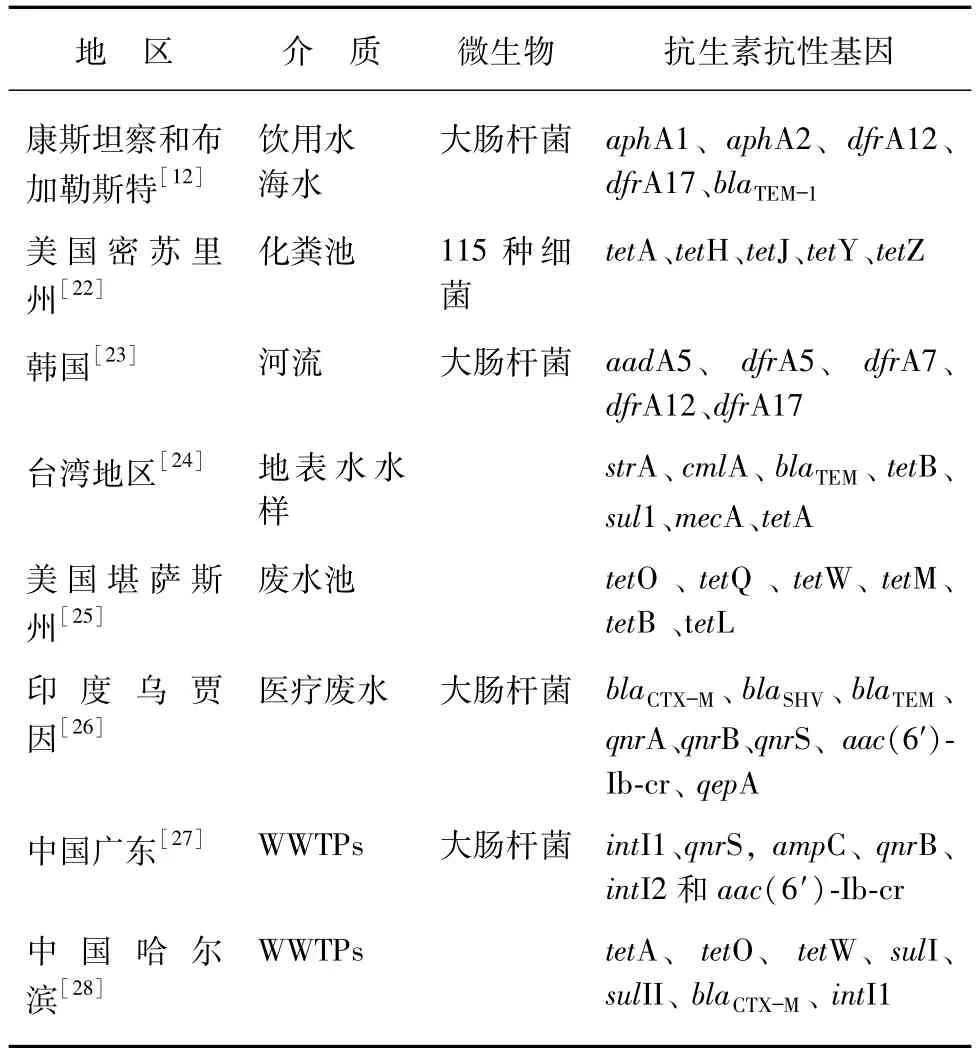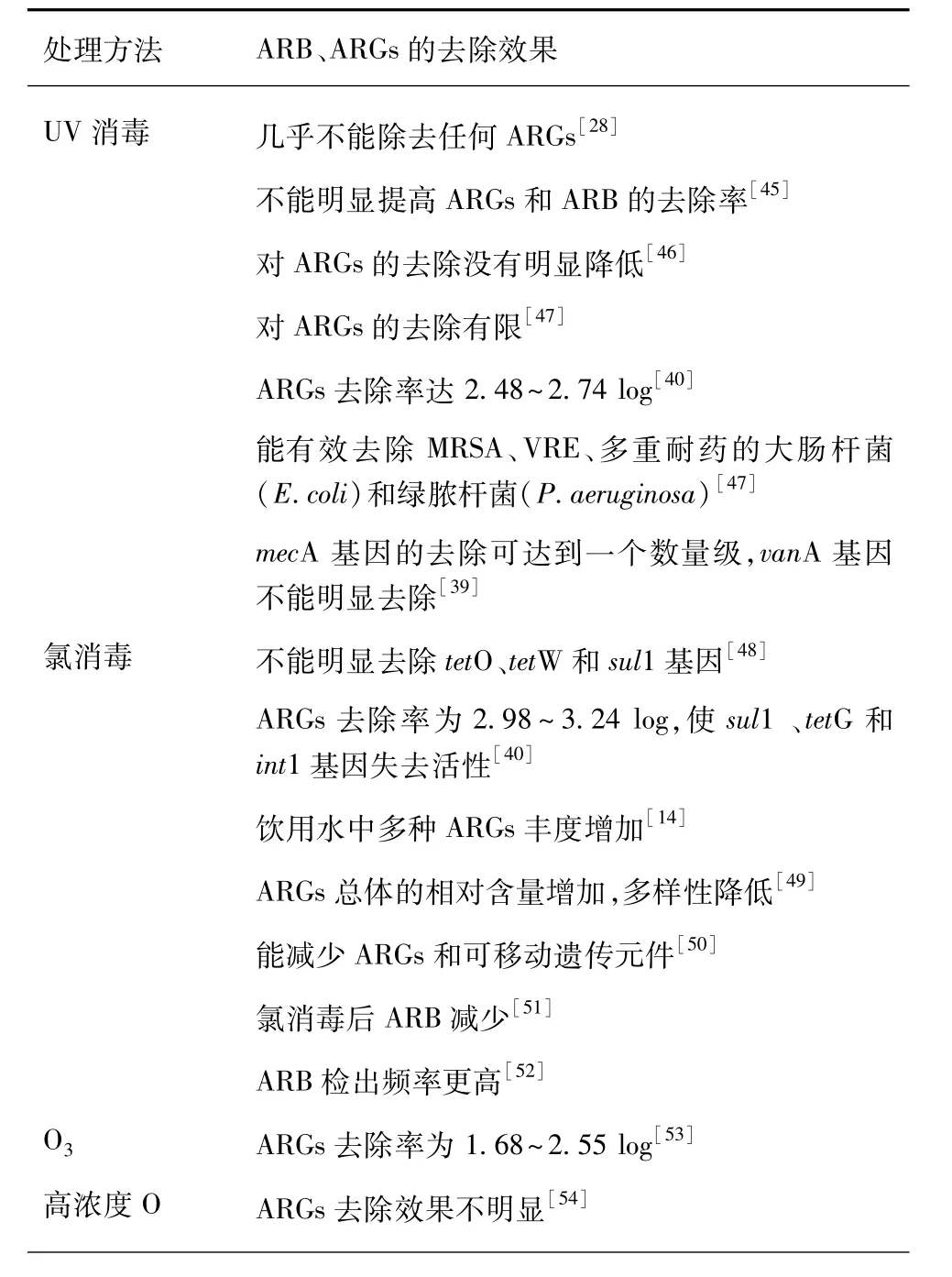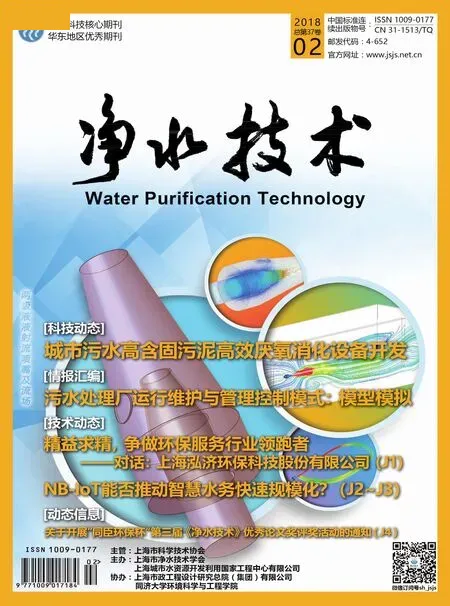消毒工艺对水体中抗生素抗性基因的去除效果
2018-03-06李金梅张舒婷
李金梅,李 曦,张舒婷
(1.沈阳化工大学环境与安全工程学院,辽宁沈阳 110142;2.中国科学院城市环境研究所,城市环境与健康重点实验室,福建厦门 361021)
抗生素抗性基因(antibiotic resistance genes,ARGs)是能对抗生素产生抗性的基因[1],是微生物,包括病原微生物,耐药性形成和扩散的物质基础,是一类新型环境污染物[2]。它能在微生物包括病原微生物间传播,还可从细菌、人类散播源和动物源等传播扩散到自然环境和饮用水系统中[3]。甚至ARGs能通过携带抗性基因的质粒等可移动遗传元件进入人体[4],致使抗生素疗效下降,细菌感染的治疗更加棘手[5]。有报道世界上每年因抗结核杆菌受影响人数达50万[6],欧盟每年约2.5万人死于感染多重抗性细菌,美国每年约6.3万人死于医院获得性细菌感染[7]。目前临床上使用的所有抗生素几乎都存在其抗性细菌(antibiotic resistance bacteria,ARB),甚至出现“超级细菌”,如“新德里.梅塔洛一号”(New Delhi-Metallo-1,NDM-1)[8]。因此,ARGs极可能引发公共健康危机。
环境中ARGs主要产生于医疗和畜牧业长期滥用或误用抗生素[1],从而使水体、土壤、活性污泥等环境介质成为ARB或ARGs的源和汇。目前,已有大量报道在水环境、土壤、沉积物中检测到ARGs,甚至空气中也检测到ARGs[9]。这些ARGs可持久存在于环境中[10],并且在携带ARGs的微生物死亡后,释放到环境中的裸露DNA分子最终又可通过基因重组转入其他微生物而使其具有抗性,给人类和动物安全带来潜在威胁。水环境已成为ARGs散播的重要介质,也是ARGs的重要贮存库之一[11]。本文阐述了ARGs在水环境中的分布,总结了目前水处理工艺中消毒对ARGs的去除效果,并探讨了消毒处理对其传播扩散的影响机制。
1 ARGs在水环境中的分布及传播扩散
ARGs和ARB已被证明在地表水、市政污水、污水处理厂出水以及饮用水中普遍存在,且种类繁多,迄今已在各种水体中检测出上百种ARGs[12-14]。例如在北美、欧洲、东亚和东南亚等地区的9个国家的饮用水、海水、地表水、医疗废水、化粪池及污水处理厂检测出大环内酯类(如 aphA1、aphA2、aadA1)、磺胺类(如 dfrA12、dfrA17、sulI)、βu 内酰胺类(如blaTEM-1、blaOXA-1、blaPSE-1)、四环素类(如 tetA、tetH、tetJ、tetY、tetZ)、青霉素类(如 mecA、penA)和大环内酯类(如 ermA、mphA)等多达 50种 ARGs[15-17](表1)。一般认为水环境中的这些ARGs主要通过医疗和水产养殖废水直接进入地表水体,也可由粪便施肥使其先进入到土壤环境,再随雨水等地表径流渗透到地下水中[18]。因此,ARGs在水环境中广泛分布,特别是污水处理厂,由于含抗生素和ARB的废水直接排入其中而富集大量ARGs,成为ARGs集聚和传播的一个重要媒介。如Su等[19]从污水厂分离到的98.4%的菌株对检测的抗生素具有抗性,90.6%的菌株至少对3种抗生素表现出抗性。水体环境中这些ARB和ARGs的存在不仅会威胁到饮用水安全,也可能影响到水资源的循环利用[20]。研究发现,用淡水和处理后废水灌溉过的土壤均检测出高水平的抗生素抗性[21]。可见,水环境中ARGs普遍存在且可能对人类健康和环境生态带来影响。

表1 水环境中的ARGsTab.1 ARGs in Water Environment
ARGs主要通过垂直基因转移(vertical gene transfer,VGT)和水平基因转移(horizontal gene transfer,HGT)两种方式进行传播扩散。垂直基因转移是依靠微生物亲代之间的分裂生殖进行;水平基因转移则是ARGs通过接合 (conjugation)、转化(transformation)、转导(transduction)、转座以及细菌溶源性基因转移等过程发生转移,从而使另一菌株获得抗性的过程[29],它是水体环境中ARGs转移扩散的重要方式。早在20世纪40年代就有微生物水平基因转移的描述[30],并提出HGT的发生是由选择性压力和生物进化产生的一种普遍现象。如有研究发现携带四环素类抗性基因的质粒在大肠埃希氏菌(Escherichia coli)和气单胞菌(Aeromonas spp.)之间进行转移[31],另外,还观察到耐万古霉素肠球菌(vancomycin-resistant Enterococcus,VRE)与耐甲氧西林金黄色葡萄球菌(methicillin-resistant Staphylococcus aureus,MRSA)间抗性基因转移现象[32]。其中,HGT对ARGs通过水传微生物进行传播扩散起到重要作用。正是由于水平基因转移的存在致使ARGs不仅可以在水体环境中从亲代传递给子代,还可以在同种属或不同种属微生物间进行基因传递。甚至在细菌、真菌、病毒和真核生物基因组均观察到基因的水平转移[33]。因此,水体环境中ARGs的存在及其通过水传微生物的转移扩散给人体健康和水的生物安全带来隐患[34]。
ARGs作为新型的环境污染物在水环境中可通过水传微生物进行散播。研究发现,在水处理过程中水传微生物携带ARGs不仅会使水体中ARGs的浓度增加[35],还可能进入到水源水和给水系统。Zhang等[15]已在饮用水系统中广泛检测到ARB和ARGs,也有报道在大型给水厂中检测到9个种或属的 ARGs且出现较高丰度[36]。而参与城市水循环的地表水更是扩散致病微生物和ARGs的重要载体之一[37]。因此,如何有效去除和控制水环境中的ARGs需要重点关注。而消毒是杀灭水中对人体健康有害的致病微生物的重要方式,可防止通过饮用水传播疾病,也是生活饮用水安全、卫生的最后保障。特别是氯消毒因其具有经济和高效的特性,因而被广泛应用于废水和饮用水消毒[38]。
2 消毒对ARGs和(或)ARB丰度的影响
消毒通常可以降低出水中的细菌总量,从而对ARGs的削减起到一定作用。但对ARGs的去除效果还会受消毒方式等的影响。目前,国内外使用的消毒方法包括化学消毒法(如卤素消毒剂、臭氧和过氧乙酸等)、物理消毒法(如膜过滤截留微生物)和光化学消毒法(如紫外线)以及电化学消毒法。广泛应用的主要有氯消毒、二氧化氯消毒、臭氧杀菌和紫外线照射及氧化消毒等[38],尽管这些消毒方法一般都能在水处理过程中去除部分ARB或ARGs,但在污水处理厂的出水中它们的检出率仍然较高,且相对总量和种类在出水中变化不大(表2)[19],甚至出现ARGs相对丰度升高现象。例如氧化和UV消毒对ARGs的去除几乎没有效果,对少数ARGs去除率能达到1~2个数量级[39],但氯消毒对ARGs的去除可以达到2~3个数量级[40],而消化处理、人工湿地及其他非消毒处理对ARGs的去除最多达到1 个数量级[41]。
由于ARGs的去除率不仅受消毒方法的影响,还会受到细菌携带抗性类型、消毒剂量和多种消毒方法结合使用等多种因素影响,因此很难明显降低或彻底清除ARGs污染。如Xu等用高通量定量PCR检测不同水处理工艺的给水厂出水时发现两给水处理厂经消毒处理的出水中ARGs的相对丰度都提高了。因为一般的给水厂或污水厂处理过程基本没有专门针对去除ARGs而设计的工艺[42],且水体中ARGs的含量还可能受补给、水量、季节变化、用途及流经地区等因素影响[43],因此物理法、化学法和生物法对ARGs的去除效果并不明显[44]。由于目前消毒工艺对ARB和ARGs的控制效应数据也还较少,所以难以提出较有效的方法和途径来遏制ARGs的散播。

表2 不同处理方法对ARB、ARGs的去除效果Tab.2 ARB and ARGs Removal Efficiency by Different Treatment Processes

续 表
消毒对ARB或ARGs的影响主要通过直接和间接两方面起作用。直接作用表现为对ARB的致死或失活作用,即直接杀死细菌或抑制抗性基因的表达[45]。间接作用是消毒添加的消毒剂及其产生的消毒副产物(disinfection by-products,DBPs)能促进ARB或ARGs的产生[57]。有报道ARB在氯消毒的水中检出频率更高,因此,氯消毒中使用的消毒剂或消毒剂与水体中腐植酸和富里酸反应后生成的DBPs对其中的细菌极可能产生选择性压力和共选择作用,从而影响ARGs的去除效率[52]。
处于消毒环境中的选择性压力下一些细菌会表现出更高的水平基因转移率和突变率,使其获得抗生素抗性更加迅速[58]。如 Ma等[59]发现当出现不同抗生素选择压力时,细菌能“感知”抗生素并决定是产生抗性还是传播抗性,Obolski等研究还发现当细菌处于压力条件下会出现更高的水平转移和突变率,当压力明显对基因变异产生影响时,抗生素抗性的出现也会受影响,并且可能促进多重抗性细菌的出现[60]。另外,共选择机制也能影响水环境中ARGs的发展。一般认为共选择是指环境中除抗生素以外的其他因素(如金属、消毒剂、DBPs和一些微污染物等)对ARB和它们相关的基因形成选择性压力[60],从而导致细菌对抗生素和其他因素的抗性同时增加,即所谓的共选择[61]。可见,氯消毒中产生的选择性压力和共选择对ARGs的增加起到一定作用。
3 消毒对ARGs水平转移的影响机制
消毒可对细菌的接合效率产生作用而影响到ARGs水平转移。如Guo等[62]发现低UV剂量(达到8 mJ/cm2)能对接合转移频率产生影响,但影响很小,而低氯消毒剂量(达到 40 mg Cl min/L)能明显提高接合转移的频率2~5倍,同时发现高剂量的UV(>10 mJ/cm2)或氯消毒(>80 mg Cl min/L)下ARGs转移的频率均相对降低。Lin等[63]也对UV和氯处理对ARGs的转移率进行了研究,发现UV和低水平氯消毒处理都能降低接合效率。表现为当UV 剂量(5~20 mJ/cm2)逐渐增加时,转移率逐渐降低,而氯消毒处理时,转移率没有变化(氯剂量为0.05~0.2 mg/L)或转移率较低甚至低于检出限(氯剂量为0.3~0.5 mg/L)。可见,UV和氯剂量较低对ARGs的水平转移几乎没有影响,当UV剂量在10~20 mJ/cm2,随着剂量的增加能使 ARGs的转移率逐渐降低。
消毒对ARGs水平转移影响的具体机制有:一是通过降低供体细菌的存活率,从而降低接合转移率;二是使细胞渗透性发生变化。研究发现氯消毒产生的氯胺能刺激细菌改变细胞渗透性,使接合细胞的表面出现更多的菌毛,提高ARGs的接合转移率,从而促进 ARGs的水平基因转移[62];三是抑制相关转移基因的表达。如较低余氯(0.05~0.2 mg/L)可能对鞭毛基因(flagellar gene,flgC)、膜外蛋白基因(an outer membrane porin gene,ompF)和DNA转移相关的基因(a DNA transport-related gene,traG)的表达产生抑制,从而降低水平基因转移率[63];四是通过集聚不同质粒、插入序列和整合子,提高ARGs水平基因转移的发生。如Shi等[14]在给水厂发现ampC、aphA2、blaTEM-1、tetA、tetG、ermA和ermB基因氯消毒后发生了富集,并通过宏基因组分析认为饮用水氯化处理确实能富集多种ARGs,同时质粒、插入序列和整合子等与ARGs的水平转移相关的可移动遗传元件也会发生集聚。可见,消毒处理时消毒剂的类型及剂量对ARGs的水平转移能起到促进作用也可能产生抑制,同时,消毒时间也会对其产生影响[14]。并且,消毒处理对ARGs和可移动遗传元件的富集作用也能进一步促进ARGs的水平基因转移。
4 总结与展望
研究发现,ARGs污染通过HGT进行传播扩散对我们人类和动物的影响甚至远远超过抗生素残留本身产生的影响。因为基因污染不同于一般环境污染物,其具有遗传性且一旦散播到环境中难以控制和消除,对人类和生态环境的影响将是长期的和不可逆的[64]。因此,如何有效预防和降低其转移扩散带来的环境影响是一项重要课题。本文分析了水环境中ARGs的广泛分布,指出水体已成为ARGs汇聚和扩散的重要介质,发现消毒在水处理中对ARGs的去除能起到一定作用,但效果不明显,甚至会出现消毒处理后ARGs相对丰度升高现象[65],即消毒能降低ARGs的绝对量,但相对丰度会增加。认为消毒能通过影响细菌的接合效率,使细胞渗透性发生变化,抑制相关转移基因的表达,对ARGs和可移动遗传元件的富集,从而对ARGs的水平转移产生作用。表现为UV剂量低于20 mJ/cm2时,对ARGs的水平转移影响较小,甚至降低水平基因转移率;而氯消毒剂量达到40~80 mg Cl min/L时,能对ARGs的水平转移起到促进作用。
目前,针对水环境中ARGs的去除,较多已有的研究只是检测水环境中消毒后ARB或ARGs的丰度变化,很少报道消毒对水环境中ARGs去除影响的具体机制。虽然也有关于多种消毒方法对ARGs去除的对比及机制探讨[45],但还是难以很好地揭示水中较高的ARB或ARGs比例,特别是在实际消毒过程中消毒及其副产物对ARGs的作用规律仍需进一步探究。另外,对于不同环境介质中ARB、ARGs及可移动遗传元件的检测与表征大体包括传统微生物培养法和分子生物学方法,但相关采样、数据分析和结果表达等需要进一步建立和完善,使其更加标准化和系统化,也方便在不同方法和实验室条件下对所得研究结果进行比较。
[1]周启星,罗义,王美娥.抗生素的环境残留、生态毒性及抗性基因污染[J].生态毒理学报,2007,2(3):244-251.
[2]Pruden A,Pei R,Storteboom H,et al.Antibiotic resistance genes as emerging contaminants:Studies in northern Colorado [J].EnvironmentalScience & Technology, 2006, 40 (23):7445-7450.
[3]Berendonk T U,Manaia C M,Merlin C,et al.Tackling antibiotic resistance:The environmental framework [J].Nature Reviews Microbiology,2015,13(5):310-317.
[4]Martinez J L.Antibiotics and antibiotic resistance genes in natural environments [J].Science,2008,321(5887):365-367.
[5]Perez F,Hujer A M,Hujer K M,et al.Global challenge of multidrug-resistant acinetobacter baumannii[J].Antimicrobial Agents and Chemotherapy,2007,51(10):3471-3484.
[6]Editor.Standing up to antimicrobial resistance [J].Nature Reviews Microbiology,2010,8(12):836.
[7]Aminov R I.A brief history of the antibiotic era:Lessons learned and challenges for the future [J].Frontiers in Microbiology,2010(1):134.
[8]Yong D,Toleman M A,Giske C G,et al.Characterization of a new metallo-beta-lactamase gene,bla(NDM-1),and a novel erythromycin esterase gene carried on a unique genetic structure in klebsiella pneumoniae sequence type 14 from India [J].Antimicrobial Agentsand Chemotherapy, 2009, 53 (12):5046-5054.
[9]Douki T,Setlow B,Setlow P.Effects of the binding of alpha/betatype small,acid-soluble spore proteins on the photochemistry of DNA in spores of bacillussubtilis and in vitro [J].Photochemistry and Photobiology,2005,81(1):163-169.
[10]Kubera L,Studzinska J,Dokladna W,et al.Microbiological air quality in some kindergartens and antibiotic resistance of bacteria of the Staphylococcus spp.genus [J].Medycyna Pracy,2015,66(1):49-56.
[11]Kummerer K.Antibiotics in the aquatic environment — A review — Part I[J].Chemosphere,2009,75(4):417-434.
[12]Cernat R B C,Ivanescu D,Nedelcu D,et al.Mechanisms of resistance in multiple-antibiotic-resistant escherichia coli strains isolated from drinking and recreational,salmaster waters [J].International Journal of Antimicrobial Agents,2007,29(7):274.
[13]Peak N,Knapp C W,Yang R K,et al.Abundance of six tetracycline resistance genes in wastewater lagoons at cattle feedlots with differentantibiotic use strategies [J]. Environmental Microbiology,2007,9(1):143-151.
[14]Shi P,Jia S,Zhang X X,et al.Metagenomic insights into chlorination effects on microbial antibiotic resistance in drinking water[J].Water Research,2013,47(1):111-120.
[15]Zhang X X,Zhang T,Fang H H.Antibiotic resistance genes in water environment[J].Applied Microbiology and Biotechnology,2009,82(3):397-414.
[16]Virginia Rabbia H B-T,Sebastian Jim enez,Mario Quezada ,et al.Antibiotic resistance in escherichia coli strains isolated from antarctic bird feces,water from inside a wastewater treatment plant,and seawater samples collected in the antarctic treaty area[J].Polar Science,2016,10(2):123-131.
[17]Baquero F,Martinez J L ,Canton R.Antibiotics and antibiotic resistance in water environments [J]. Current Opinion in Biotechnology,2008,19(3):260-265.
[18]Wellington E M,Boxall A B,Cross P,et al.The role of the natural environment in the emergence of antibiotic resistance in gram-negative bacteria [J].The Lancet Infectious Diseases,2013,13(2):155-165.
[19]Su H C,Ying G G,He L Y,et al.Antibiotic resistance,plasmidmediated quinolone resistance(PMQR)genes and ampC gene in two typicalmunicipalwastewater treatmentplants [J].Environmental Science Processes& Impacts,2014,16(2):324-332.
[20]Pruden A.Balancing water sustainability and public health goals in the face of growing concerns about antibiotic resistance [J].Environmental Science& Technology,2014,48(1):5-14.
[21]Negreanu Y,Pasternak Z,Jurkevitch E,et al.Impact of treated wastewater irrigation on antibiotic resistance in agricultural soils[J].Environmental Science & Technology,2012,46(9):4800-4808.
[22]Macauley J J A C,Mormile M R.Diversity of tet resistance genes in tetracycline resistant bacteria isolated from a swine lagoon with low antibiotic impact [J].Canadian Journal of Microbiology,2007,53(12):1307-1315.
[23]Park J J,Jeong Y W,Cho J W,et al.Antibiotic selective pressure for the maintenance of antibiotic resistant genes in coliform bacteria isolated from the aquatic environment[J].Water Science &Technology,2003,47(3):249-253.
[24]Yu Chao,Chang Tienyu,Kao Pomin,et al.Potential association between antibiotic abuse and existence of related resistance genes in different aquatic environments[J].Water Air& Soil Pollution,2015,226(1):2235.
[25]Peak W K,Richard K Y.Abundance of six tetracycline resistance genes in wastewater lagoons at cattle feed lots with different antibiotic use strategies [J].Environmental Microbiology,2007,9(1):143-151.
[26]Diwan V,Chandran S P,Tamhankar A J,et al.Identification of extended-spectrum-lactamase and quinolone resistance genes in Escherichia coli isolated from hospital wastewater from central India[J].Journal of Antimicrobial Chemotherapy,2012,67(4):857-859.
[27]Su H C,Ying G G,He L Y,et al.Antibiotic resistance,plasmidmediated quinolone resistance(PMQR)genes and ampC gene in two typical municipal wastewater treatment plants [J].Environmental Science Processes & Impacts,2014,16 (2):324-332.
[28]Wen Q,Yang L,Duan R,et al.Monitoring and evaluation of antibiotic resistance genes in four municipal wastewater treatment plants in Harbin,northeast China [J].Environmental Pollution ,2016,30(5):34-40.
[29]Nongkhlaw F M,Joshi S R.Horizontal gene transfer of the nonribosomal peptide synthetase gene among endophytic and epiphytic bacteria associated with ethnomedicinalplants [J].Current Microbiology,2016,72(1):1-11.
[30]Tatum E L,Lederberg J.Gene recombination in the bacterium escherichia coli[J].Journal of Bacteriology,1947,53(6):673-684.
[31]Glenn G H, Jean S, Patrick M, etal. Distribution of oxytetracycline resistance plasmids between aeromonads in hospital and aquaculture environments:Implication of Tn1721 in dissemination of the tetracycline resistance determinant Tet A [J].Applied and EnvironmentalMicrobiology,2000,66 (9):3883-3890.
[32]Mc Kinley L,Becerra B,Moriarty H,et al.Vancomycin-resistant enterococcus co-colonization rates with methicillin-resistant staphylococcus aureus and clostridium difficile in critically ill veterans [J].American Journal of Infection Control,2016,44(9):1047-1049.
[33]Bansal A K.Meyer T E.Evolutionary analysis by whole-genome comparisons[J].Journal of Bacteriology,2002,184(8):2260-2272.
[34]Zhang S,Lu L,Zhang Y,et al.Occurrence and variations of five classes of antibiotic resistance genes along the Jiulong River in southeast China [J].Journal of Environmental Biology,2013,34(2):345-351.
[35]Deligianni E,Pattison S,Berrar D,et al.Pseudomonas aeruginosa cystic fibrosis isolates of similar RAPD genotype exhibit diversity in biofilm forming ability in vitro [J].BMC Microbiology,2010,10(1):38.
[36]Zhang S,Lin W,Yu X.Effects of full-scale advanced water treatment on antibiotic resistance genes in the Yangtze Delta area in China [J].Fems Microbiology Ecology,2016,92(5):65.
[37]Kümmere K.Antibiotics in the aquatic environment— A review —Part I[J].Chemosphere,2009,75(4):417-434.
[38]张晓健,黄霞.水与废水物化处理的原理与工艺[M].北京:清华大学出版社,2011.
[39]Mckinney C M Y,Novak J T,Pruden A.Disinfection of microconstituent antibiotic resistance genes by UV light and sludge digestion [J].Proceeding of the Water Environment Federation,2009,20 (11):577-589.
[40]Zhuang Y,Ren H,Geng J,et al.Inactivation of antibiotic resistance genes in municipal wastewater by chlorination,ultraviolet,and ozonation disinfection [J].Environmental Science and Pollution Research International,2015,22(9):7037-7044.
[41]Brjesson S M A,Lindgren P E.Genes encoding tetracycline resistance in a full-scale municipal wastewater treatment plant investigated during one year[J].Water Health,2010,8 (2):247-256.
[42]Zhang T,Yang Y,Pruden A.Effect of temperature on removal of antibiotic resistance genes by anaerobic digestion of activated sludge revealed by metagenomic approach [J].Applied Microbiology &Biotechnology,2015,99(18):7771-7779.
[43]Hsu C Y,Hsu B M,Ji W T,et al.A potential association between antibiotic abuse and existence of related resistance genes in different aquatic environments[J].Water Air& Soil Pollution,2015,226(1):2235.
[44]Munir M,Wong K ,Xagoraraki I.Release of antibiotic resistant bacteria and genes in the effluent and biosolids of five wastewater utilities in Michigan [J].Water Research,2011,45(2):681-693.
[45]Lin W,Li S,Zhang S,et al.Reduction in horizontal transfer of conjugative plasmid by UV irradiation and low-level chlorination[J].Water Research,2016,91(6):331-338.
[46]Chen H,Zhang M.Effects of advanced treatment systems on the removal of antibiotic resistance genes in wastewater treatment plants from Hangzhou,China [J].Environmental Science & Technology,2013,47(15):8157-8163.
[47]Mckinney C W,Pruden A.Ultraviolet disinfection of antibiotic resistant bacteria and their antibiotic resistance genes in water and wastewater[J].Environmental Science & Technology,2012,46(24):13393-13400.
[48]Gao P,Munir M,Irene Xagoraraki.Correlation of tetracycline and sulfonamide antibiotics with corresponding resistance genes and resistant bacteria in a conventional municipal wastewater treatment plant[J].Science of the Total Environment,2012,421-422(3):173-183.
[49]Jia S,Shi P,Hu Q,et al.Bacterial community shift drives antibiotic resistance promotion during drinking water chlorination[J].Environmental Science & Technology,2015,49(20):12271-12279.
[50]Lin W ,Zhang M,Zhang S,et al.Can chlorination co-select antibiotic-resistance genes? [J].Chemosphere, 2016, 156:412-419.
[51]Huang J J,Hu H Y,Tang F,et al.Inactivation and reactivation of antibiotic-resistant bacteria by chlorination in secondary effluents of a municipal wastewater treatment plant [J].Water Research,2011,45(9):2775-2781.
[52]Armstrong J L,Calomiris J,Seidler R J.Selection of antibioticresistant standard plate count bacteria during water treatment[J].Applied and EnvironmentalMicrobiology, 1982, 44 (2):308-316.
[53]Zhuang Y,Ren H,Geng J,et al.Inactivation of antibiotic resistance genes in municipal wastewater by chlorination,ultraviolet,and ozonation disinfection [J].Environmental Science and Pollution Research International, 2015, 22 (9 ):7037-7044.
[54]Ibanez M,Gracia-Lor E,Bijlsma L,et al.Removal of emerging contaminants in sewage water subjected to advanced oxidation with ozone [J].Journal of Hazardous Materials,2013,260(1):389-398.
[55]Ferro G,Guarino F,Castiglione S,et al.Antibiotic resistance spread potential in urban wastewater effluents disinfected by UV/H2O2process [J].Science of the Total Environment,2016,45(8):29-35.
[56]Rizzo L,Manaia C,Merlin C,et al.Urban wastewater treatment plants as hotspots for antibiotic resistant bacteria and genes spread into the environment:A review [J].The Science of the Total Environment,2013,447(9):345-360.
[57]Lu L,Jiang T,Zhang S,et al.Exposure to mutagenic disinfection byproducts leads to increase of antibiotic resistance in pseudomonas aeruginosa [J].Environmental Science & Technology,2014,48(14):8188-8195.
[58]D'Costa V M,King C E,Kalan L,et al.Antibiotic resistance is ancient[J].Nature,2011,477(7365):457-461.
[59]Ma H,Bryers J D.Non-invasive determination of conjugative transfer of plasmids bearing antibiotic-resistance genes in biofilmbound bacteria:Effects of substrate loading and antibiotic selection[J].Applied Microbiology and Biotechnology,2013,97(1):317-328.
[60]Lu L,Jiang T,Zhang S,et al.Exposure to mutagenic disinfection byproducts leads to increase of antibiotic resistance in pseudomonas aeruginosa [J].Environmental Science & Technology,2014,48(14):8188-8195.
[61]Chapman J S. Disinfectantresistance mechanisms, crossresistance,and coresistance [J].International Biodeterioration Biodegration,2003,51(4):271-276.
[62]Guo M T,Yuan Q B,Yang J.Distinguishing effects of ultraviolet exposure and chlorination on the horizontal transfer of antibiotic resistance genes in municipal wastewater [J].Environmental Science & Technology,2015,49(9):5771-5778.
[63]Lin W,Li S,Zhang S,et al.Reduction in horizontal transfer of conjugative plasmid by UV irradiation and low-level chlorination[J].Water Research,2016,50(6):331-338.
[64]王丽梅,罗义,毛大庆,等.抗生素抗性基因在环境中的传播扩散及抗性研究方法[J].应用生态学报,2010,21(4):1063-1069.
[65]Shi P,Jia S,Zhang X X,et al.Metagenomic insights into chlorination effects on microbial antibiotic resistance in drinking water[J].Water Research,2013,47(1):111-120.
